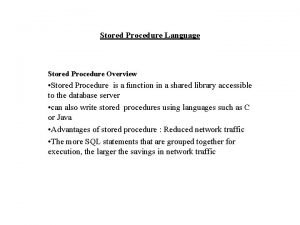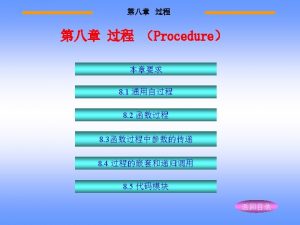Evolution Strategies An Example Evolution Strategy Procedure ES










- Slides: 10

Evolution Strategies • An Example Evolution Strategy Procedure ES{ t = 0; Initialize P(t); Evaluate P(t); While (Not Done) { Parents(t) = Select_Parents(P(t)); Offspring(t) = Procreate(Parents(t)); Evaluate(Offspring(t)); P(t+1)= Select_Survivors(P(t), Offspring(t)); t = t + 1; }

Evolution Strategies • There are basically 4 types of ESs – – The Simple (1+1)-ES The ( +1)-ES (The first multimembered ES) The ( + )-ES, and The ( , )-ES.

Evolution Strategies: The Simple (1+1)-ES • The simple (1+1)-ES has the following attributes: – Individuals are represented as follows: • – <xi, 0, xi, 1, …, xi, n-1, i>, where n is the number of variables Offspring are created as follows: +i, j = k, j * exp( 0 * N(0, 1)); x +i, j = xk, j + +i, j. N +i, j(0, 1); Where j represents the jth variable. And where 0 1/sqrt(n)(Global Learning Rate) – Uses the 1/5 Success Rule to Adapt the Step Size: • • If more than 1/5 th of the mutations cause an improvement (in the objective function) then multiply by 1. 2, If less than 1/5 th of the mutations cause an improvement, then multiply by 0. 8.

Evolution Strategies: The Simple (1+1)-ES • } Procedure simple. ES{ t = 0; Initialize P(t); /* = 1, = 1 */ Evaluate P(t); while (t <= (4000 - )/ ){ for (i=0; i<1; i++){ Create_Offspring(<xi, yi, i>, <x +i, y +i, +i>): +i = i * exp( 0 * N(0, 1)); x +i = xi + +i. N +i, x(0, 1); y +i = yi + +i. N +i, y(0, 1); fit +i = Evaluate(<x +i, y +i>); } P(t+1) = Better of 2 individuals; t = t + 1; }

Evolution Strategies: The Simple (1+1)-ES • How is a simple (1+1)-ES similar to a (1+1)-Standard EP? • In what ways are the two different?

Evolution Strategies: The ( +1)-ES • Since the ( +1)-ES is multi-membered, crossover can be used. • According to, Bäck, T. , Hoffmeister, F, and Schwefel, H. -P. (1991). “A Survey of Evolution Strategies”, The Proceedings of the 4 th International Conference on Genetic Algorithms, R. K. Belew and L. B. Booker Eds. , pp. 2 -9, Morgan Kaufmann. [can be found at: http: //citeseer. nj. nec. com/back 91 survey. html] – Uniform Crossover (also referred to a discrete recombination) can be used on the variable values as well as the strategy parameter. • Adaptation of the step-size is not used in the ( +1)-ES.

Evolution Strategies: The ( +1)-ES Procedure ( +1)-ES{ t = 0; Initialize P(t); /* of individuals */ Evaluate P(t); while (t <= (4000 - )){ Create_Offspring(<xi, yi, i>, <x +i, y +i, +i>): +i = i * exp( 0 * N(0, 1)); x +i = xi + +i. N +i, x(0, 1); y +i = yi + +i. N +i, y(0, 1); fit +i = Evaluate(<x +i, y +i>); P(t+1) = Best of the +1 individuals; t = t + 1; } }

Evolution Strategies: The ( + )-ES • In the ( + )-ES, an individual, i, is represented as follows: • <xi, 0, xi, 1, …, xi, n-1, i, 0, i, 1, …, i, n-1>, where n is the number of variables • Offspring are created by as follows: – +i, j = k, j * exp( ’ * N(0, 1) + * N +i(0, 1)); x +i, j = xk, j + +i, j. N +i, j(0, 1); - Where j represents the jth variable, - ’ 1/sqrt(2 n) /* Global Learning Rate */ - 1/sqrt(2*sqrt(n)) /* Individual Learning Rate */ • The 1/5 th success rule is used.

Evolution Strategies: The ( + )-ES Procedure ( + )-ES{ t = 0; Initialize P(t); /* of individuals */ Evaluate P(t); while (t <= (4000 - )/ ){ for (i=0; i< ; i++){ Create_Offspring(<xk, yk, k, x, k, y>, <x +i, y +i, x, +i, y>): +i, x = k, x * exp( ’ * N(0, 1) + * N +i(0, 1)); x +i = xi + +i, x N +i, x(0, 1); +i, y = k, y * exp( ’ * N(0, 1) + * N +i(0, 1)); y +i = yi + +i, y N +i, y(0, 1); fit +i = Evaluate(<x +i, y +i>); } P(t+1) = Best of the + individuals; t = t + 1; } }

Evolution Strategies: The ( , )-ES Procedure ( , )-ES{ t = 0; Initialize P(t); /* of individuals */ Evaluate P(t); while (t <= (4000 - )/ ){ for (i=0; i< ; i++){ Create_Offspring(<xk, yk, k, x, k, y>, <x +i, y +i, x, +i, y>): +i, x = k, x * exp( ’ * N(0, 1) + * N +i(0, 1)); x +i = xi + +i, x N +i, x(0, 1); +i, y = k, y * exp( ’ * N(0, 1) + * N +i(0, 1)); y +i = yi + +i, y N +i, y(0, 1); fit +i = Evaluate(<x +i, y +i>); } P(t+1) = Best of the offspring; t = t + 1; } }
 Aggregate planning chase strategy example
Aggregate planning chase strategy example Strategic staffing definition
Strategic staffing definition Corporate strategy vs business strategy
Corporate strategy vs business strategy Firms that emphasize global integration make and sell
Firms that emphasize global integration make and sell Transnational global strategy
Transnational global strategy Aligning hr strategy with business strategy
Aligning hr strategy with business strategy Integration responsiveness grid
Integration responsiveness grid Masterful strategies come from
Masterful strategies come from Strategy formulation vs strategy implementation
Strategy formulation vs strategy implementation Listening strategies activities
Listening strategies activities Directional strategies in strategic management
Directional strategies in strategic management



















